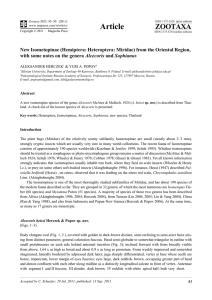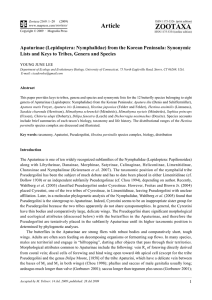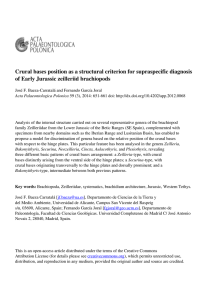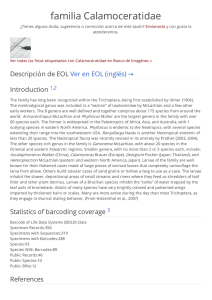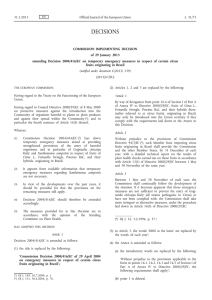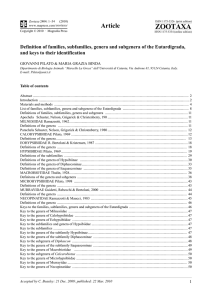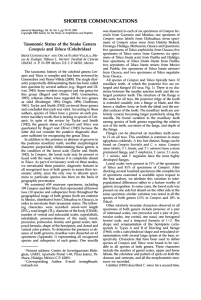Fruit characters in Malesian Euphorbiaceae
Anuncio
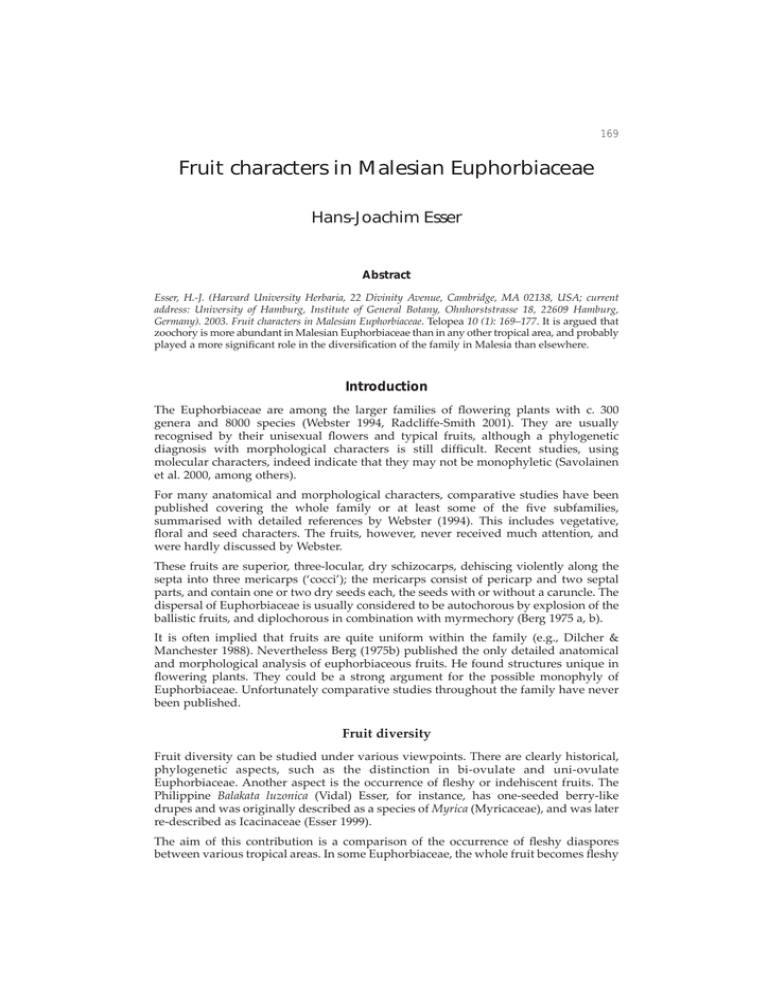
169 Fruit characters in Malesian Euphorbiaceae Hans-Joachim Esser Abstract Esser, H.-J. (Harvard University Herbaria, 22 Divinity Avenue, Cambridge, MA 02138, USA; current address: University of Hamburg, Institute of General Botany, Ohnhorststrasse 18, 22609 Hamburg, Germany). 2003. Fruit characters in Malesian Euphorbiaceae. Telopea 10 (1): 169–177. It is argued that zoochory is more abundant in Malesian Euphorbiaceae than in any other tropical area, and probably played a more significant role in the diversification of the family in Malesia than elsewhere. Introduction The Euphorbiaceae are among the larger families of flowering plants with c. 300 genera and 8000 species (Webster 1994, Radcliffe-Smith 2001). They are usually recognised by their unisexual flowers and typical fruits, although a phylogenetic diagnosis with morphological characters is still difficult. Recent studies, using molecular characters, indeed indicate that they may not be monophyletic (Savolainen et al. 2000, among others). For many anatomical and morphological characters, comparative studies have been published covering the whole family or at least some of the five subfamilies, summarised with detailed references by Webster (1994). This includes vegetative, floral and seed characters. The fruits, however, never received much attention, and were hardly discussed by Webster. These fruits are superior, three-locular, dry schizocarps, dehiscing violently along the septa into three mericarps (‘cocci’); the mericarps consist of pericarp and two septal parts, and contain one or two dry seeds each, the seeds with or without a caruncle. The dispersal of Euphorbiaceae is usually considered to be autochorous by explosion of the ballistic fruits, and diplochorous in combination with myrmechory (Berg 1975 a, b). It is often implied that fruits are quite uniform within the family (e.g., Dilcher & Manchester 1988). Nevertheless Berg (1975b) published the only detailed anatomical and morphological analysis of euphorbiaceous fruits. He found structures unique in flowering plants. They could be a strong argument for the possible monophyly of Euphorbiaceae. Unfortunately comparative studies throughout the family have never been published. Fruit diversity Fruit diversity can be studied under various viewpoints. There are clearly historical, phylogenetic aspects, such as the distinction in bi-ovulate and uni-ovulate Euphorbiaceae. Another aspect is the occurrence of fleshy or indehiscent fruits. The Philippine Balakata luzonica (Vidal) Esser, for instance, has one-seeded berry-like drupes and was originally described as a species of Myrica (Myricaceae), and was later re-described as Icacinaceae (Esser 1999). The aim of this contribution is a comparison of the occurrence of fleshy diaspores between various tropical areas. In some Euphorbiaceae, the whole fruit becomes fleshy 170 Telopea 10(1): 2003 and will attract animals (e.g., in Antidesma Burm. ex L.), whereas in others the dry fruit wall falls off easily, exposing fleshy and attractively coloured seeds (e.g., in Sapium Jacq. and Triadica Lour.). For the purpose of this study I will distinguish between ‘typical’ fruits of Euphorbiaceae (i.e., dry seeds and fruits, and most probably autochorous), and probable adaptations to zoochory (including fleshy or indehiscent fruits as well as fleshy seeds). In most cases, dispersers will probably be birds (ornithochory), but this will not be distinguished here. The recognition of zoochory is sometimes difficult from herbarium collections alone, and it is also not strictly distinguished in nature. Several Euphorbiaceae have basically dry and woody fruits that show reddish colours and may be dispersed by birds if small enough, although not clearly adapted to ornithochory (observed in scattered field notes and herbarium labels). Spiny-echinate fruits can be found in numerous genera in all tropical areas (such as Mallotus Lour. or Chaetocarpus Thwaites). These fruits are usually dry, which could indicate epizoochory, but could also be a protection of autochorous fruits against herbivory. The absence or presence of a caruncle on the seeds is not analysed here. It has a probable phylogenetic background, because a caruncle is consistently absent in Phyllanthoideae but variable and often present in other subfamilies, without an obvious correlated distinction in ecology etc. between the subfamilies. It is also variable within numerous genera of the family (such as Croton L., Euphorbia L.), and it is therefore difficult to compare at the genus level. Methods Data on the generic diversity of Euphorbiaceae were extracted from published accounts for Malesia and three other tropical areas for which recent and reliable revisions are available. Cultivated, exotic taxa were omitted. The family is currently under revision for Flora Malesiana, and data on diversity in Malesia (Table 1) are taken from the regularly updated Malesian Euphorbiaceae Newsletter (Welzen 1997, 2000), separate revisions cited therein, and own unpublished estimations for Breynia, Croton and Euphorbia. The species numbers exclude Thai taxa not known from Malesia. Data for extra-Malesian regions were taken, unchanged, for Tropical East Africa (Table 2, after Carter & Radcliffe-Smith 1988, Radcliffe-Smith 1987), Costa Rica (Table 3, after Burger & Huft 1996), and the Venezuelan Guayana (Table 4, after Webster et al. 1999). These areas are much smaller than Malesia, and the focus is therefore not on absolute numbers of taxa. Diaspores were distinguished into presumably autochorous and zoochorous. These data were extracted from the cited references and usually verified in the herbarium. For Malesia, however, a considerable part of the family has not been revised yet (more than 60 genera are listed as such by Welzen 2000), and here the data are based on own observations on herbarium specimens only. Because of the mentioned uncertainties (ongoing studies of Malesian Euphorbiaceae, sometimes problematic classification of dispersal syndromes in certain genera) no further statistics will be applied, and the data should be understood as preliminary at this stage. Esser, Fruit characters in Malesian Euphorbiaceae 171 Results and Discussion Although this study was mainly based on a compilation from available publications, it leads to some conclusions that have not been discussed much before. The comparison of Tables 1 to 4 shows a number of interesting patterns: Although there is a considerable range of fruit types within Euphorbiaceae as a whole, only very few genera are variable in their fruit type: Alchornea, Mallotus, Omphalea, Phyllanthus, and Shirakiopsis. The largest ones of these (Mallotus and Phyllanthus) are probably unnatural in their present circumscription (Slik & Welzen 2001, K. Wurdack pers. comm.). Alchornea is mentioned here with some doubt because only in the Neotropics do the fruits tend to show a slightly fleshy pericarp, tardily dehiscent, but are not clearly zoochorous. Variation in dispersal syndrome as distinguished here is usually found above the genus level only. In Malesia the proportion of genera and species with fleshy, presumably zoochorous diaspores is higher than in Africa or the Neotropics (Table 5). This difference is even more obvious in species numbers than in numbers of genera. Whereas in all regions compared more than 50% of all genera have dry and dehiscent fruits, it is only in Malesia that the majority of species of Euphorbiaceae has zoochorous diaspores. A large proportion of the genera endemic to, or most diversified in, Malesia shows zoochory, in particular most of the largest Malesian genera (such as Antidesma, Macaranga). This is very different in the African and American regions compared, where the most species-rich genera have ‘typical’ dry schizocarps. Most pantropical genera of Euphorbiaceae have dry, dehiscent fruits (such as Acalypha, Croton, Euphorbia, Microstachys) or are variable, with a large proportion of autochory (such as Phyllanthus). All of these are comparatively poorly diversified in Malesia, with the centre of diversity in other continents. The only pantropical zoochorous genera are Drypetes (which probably has to be excluded from the family, as discussed by, e.g., Wurdack & Chase 1996) and Margaritaria (which is the smallest of the pantropical genera with 14 species). Webster (1994: 18, table 3) included a brief comparison between geography and dispersal type in genera of Euphorbiaceae, and concluded that ornithochory is prevalent in tropical Asia and in Africa/Madagascar in contrast to the other continents. His data could not be confirmed in the present contribution. At the genus level, autochory is prevalent on all continents, although there seems to be a difference between Old World and New World. The diversification of zoochorous Euphorbiaceae is however certainly more obvious in Malesia than in Africa when numbers of species are considered, as done here. Schizocarps and autochory were most probably the plesiomorphic conditions in Euphorbiaceae (Webster 1994). It can therefore be postulated that zoochorous dispersal (in most cases probably ornithochory) played a significant and underestimated role in the evolution and diversification of Malesian Euphorbiaceae, much more than it did on other tropical continents. This contribution is only a first and preliminary step in the comparative study of Euphorbiaceae fruits, focussing on one particular aspect. It is nevertheless apparent that additional studies are desirable. For instance, a more detailed distinction between forest and savanna ecosystems and their respective dispersal syndromes within the regions compared here might be interesting. A more detailed comparison of ‘typical’ dry schizocarps within the family will be undertaken in a forthcoming publication. 172 Telopea 10(1): 2003 Table 1. Malesian genera of Euphorbiaceae and the presence of zoochorous diaspores. Nomenclature follows Radcliffe-Smith (2001). Genera are sorted according to their species number. a/d = autochorous/diplochorous diaspores; z = presumably zoochorous diaspores; v = variable diaspore type. Number of species Genus Diaspore type Overall number of species Distribution 175 150 108 70 63 61 60 60 55 52 42 39 30 Macaranga Glochidion Phyllanthus Antidesma Drypetes Mallotus Claoxylon Cleistanthus Croton Aporosa Trigonostemon Baccaurea Euphorbia (incl. Chamaesyce) Acalypha Breynia Actephila Bridelia Codiaeum Homalanthus Ptychopyxis Sauropus Endospermum Alchornea Dimorphocalyx Koilodepas Cleidion Blumeodendron Galearia Neoscortechinia Suregada Agrostistachys Cephalomappa Excoecaria Jatropha Cnesmone Omphalea Pimelodendron Distichirhops Epiprinus Micrococca Shirakiopsis Trigonopleura Aleurites Ashtonia Balakata Chondrostylis Dalechampia z z v z z v z a/d a/d z a/d z a/d 280 300 800 170 200 150 80 140 800 80 50–60 43 2000 Africa to Pacific Islands Madagascar to Pacific Islands pantropical Africa to Pacific Islands pantropical Indopacific Madagascar to Indopacific Africa to Pacific Islands pantropical India to Malesia India to Australia India to Pacific Islands worldwide a/d z a/d z a/d z z z z a/d a/d a/d a/d a/d z a/d z a/d a/d a/d a/d a/d v z z a/d z v a/d z z z a/d a/d 450 35 20 60 16 20 12 80 12 60 20 10–12 25 6 6 6 31 10 6 35 175 12 20 6–8 3 6 12 6 3 2 2 2 2 110 pantropical India to New Caledonia Australasia Africa to Asia Malesia to Pacific Islands Malesia to Pacific Islands Thailand and Malesia India to China and Australia India to China and Australia pantropical India to Malesia India to China pantropical Burma to Malesia Burma to Malesia Burma to Malesia Africa to Asia India to Malesia China to Malesia Africa to Polynesia pantropical Southeast Asia pantropical Malesia to Australia endemic India to Malesia Africa to Asia Africa to Asia endemic India to Pacific Islands endemic India to Malesia Thailand to Malesia pantropical 28 21 15 15 14 12 12 12 11 10 10 9 8 7 6 6 6 5 5 5 5 4 4 4 3 3 3 3 3 2 2 2 2 2 Esser, Fruit characters in Malesian Euphorbiaceae 173 Number of species Genus Diaspore type Overall number of species Distribution 2 2 2 2 2 2 2 2 2 2 1 1 1 1 1 1 1 1 1 1 1 1 1 1 1 1 1 1 1 1 1 1 1 1 1 1 1 1 1 1 1 1 1 1 1 1 1 1 1 1 1 1 1 1 Erismanthus Flueggea Fontainea Gymnanthes Lasiococca Leptopus Margaritaria Spathiostemon Syndyophyllum Wetria Alphandia Annesijoa Austrobuxus Baliospermum Bischofia Blachia Borneodendron Botryphora Chaetocarpus Cheilosa Choriceras Chrozophora Cladogynos Clonostylis Dicoelia Doryxylon Elateriospermum Erythrococca Falconeria Homonoia Hymenocardia Kairothamnus Loerzingia Megistostigma Melanolepis Microdesmis Microstachys Moultonianthus Neotrewia Octospermum Ostodes Pachystylidium Paracroton Petalostigma Plukenetia Reutalis Richeriella Stillingia Strophioblachia Sumbaviopsis Tapoides Trewia Triadica Vernicia a/d z z a/d a/d a/d z a/d a/d a/d a/d a/d a/d a/d z a/d a/d a/d a/d a/d a/d z a/d a/d a/d z a/d z z z a/d a/d a/d z z z a/d a/d z z a/d a/d a/d z a/d a/d a/d a/d a/d z a/d z z a/d 2 15 6 45 5 10 14 4 2 2 3 1 20 12 1 15 1 1 13 1 2 10 1 1 1 1 1 50 1 2 9 1 1 5 2 10 17 1 1 1 1–3 1 3 6 15 1 2 27 1 1 1 1 3 3 Malesia to China Paleotropics, temperate Eurasia New Guinea to Australia pantropical India to China Asia, Australia, America pantropical Thailand to Malesia endemic Burma to Malesia Malesia to New Caledonia endemic Malesia to Fiji and Australia India to China Malesia to Pacific Islands India to Southeast Asia endemic Burma to Malesia America, Madagascar, Asia endemic New Guinea to Australia Mediterranean to East Asia Southeast Asia endemic endemic endemic Thailand to Malesia mostly Africa India to Malesia India to Malesia Africa to Asia endemic endemic Burma to Malesia Malesia to Indochina Africa to Asia pantropical endemic endemic endemic Himalaya to Malesia India to Malesia India to Malesia New Guinea to Australia pantropical endemic Malesia to China nearly pantropical Malesia to China India to Malesia endemic India to China India to China Burma to East Asia 174 Telopea 10(1): 2003 Table 2. Genera of Euphorbiaceae in tropical East Africa and the presence of zoochorous diaspores. Genera are sorted according to their species number. a/d = autochorous/diplochorous diaspores; z = presumably zoochorous diaspores; v = variable diaspore type. Number of species Genus Diaspore type 208 52 30 27 23 22 15 10 8 8 7 6 5 4 4 3 3 3 3 3 3 2 2 2 2 2 2 2 2 2 2 1 1 1 1 1 1 1 1 1 1 1 1 1 1 1 1 1 1 1 1 1 1 Euphorbia Phyllanthus Acalypha Tragia Croton Jatropha Erythrococca Drypetes Bridelia Macaranga Clutia Zimmermannia Alchornea Dalechampia Micrococca Caperonia Meineckia Pycnocoma Suregada Thecacoris Tragiella Argomuellera Cephalocroton Cleistanthus Excoecaria Maprounea Neoboutonia Oldfieldia Ricinodendron Spirostachys Tetrorchidium Andrachne Aristogeitonia Cavacoa Chrozophora Crotonogynopsis Discoclaoxylon Discoglypremna Flueggea Givotia Heywoodia Maesobotrya Mallotus Mareya Margaritaria Mildbraedia Necepsia Neoholstia Omphalea Paranecepsia Pseudagrostistachys Pseudolachnostylis Savia a/d v a/d a/d a/d a/d z z z z a/d a/d a/d a/d z z a/d a/d z a/d a/d a/d a/d a/d a/d z a/d z z a/d z a/d a/d a/d z a/d z z a/d z a/d z z a/d z a/d a/d a/d a/d a/d a/d a/d a/d Esser, Fruit characters in Malesian Euphorbiaceae Table 2 cont. Number of species 1 1 1 1 1 Genus Sclerocroton Shirakiopsis Sibangea Spondianthus Tannodia 175 Diaspore type a/d a/d z a/d a/d Table 3. Genera of Euphorbiaceae in Costa Rica and the presence of zoochorous diaspores. Genera are sorted according to their species number. a/d = autochorous/diplochorous diaspores; z = presumably zoochorous diaspores; v = variable diaspore type. Number of species Genus Diaspore type 32 32 19 13 10 6 6 5 4 4 3 3 3 3 2 2 2 2 2 1 1 1 1 1 1 1 1 1 1 1 1 1 1 1 1 1 1 1 1 1 1 1 1 Croton Euphorbia (incl. Chamaesyce) Acalypha Phyllanthus Dalechampia Jatropha Sapium Alchornea Tetrorchidium Manihot Cnidoscolus Drypetes Mabea Tragia Bernardia Caperonia Gymnanthes Hieronyma Plukenetia Acidoton Actinostemon Adelia Adenophaedra Alchorneopsis Amanoa Aparisthmium Argythamnia Astrocasia Caryodendron Conceveiba Dysopsis Garcia Hippomane Hura Margaritaria Microstachys Omphalea Pausandra Pedilanthus Pera Richeria Sagotia Stillingia a/p a/p a/p v a/p a/p z v z a/p z z a/p a/p a/p z a/p z a/p a/p a/p a/p a/p z a/p a/p a/p a/p a/p a/p a/p a/p z a/p z a/p v a/p a/p a/p z a/p v 176 Telopea 10(1): 2003 Table 4. Genera of Euphorbiaceae in the Venezuelan Guayana and the presence of zoochorous diaspores. Genera are sorted according to their species number. a/d = autochorous/diplochorous diaspores; z = presumably zoochorous diaspores; v = variable diaspore type. Number of species Genus Diaspore type 45 43 15 14 11 9 7 6 6 6 5 5 4 4 4 3 2 2 2 2 2 2 2 2 2 2 2 1 1 1 1 1 1 1 1 1 1 1 1 1 1 1 1 1 1 1 1 1 1 1 1 1 1 1 1 1 Croton Phyllanthus Mabea Dalechampia Euphorbia (incl. Chamaesyce) Acalypha Micrandra (incl. Cunuria) Amanoa Manihot Pera Alchornea Plukenetia (incl. Apodandra) Conceveiba Hevea Sapium Discocarpus Actinostemon Dendrothrix Drypetes Hieronyma Jatropha Maprounea Piranhea Sagotia Sandwithia Senefelderopsis Tragia Acidoton Adelia Adenophaedra Alchorneopsis Aparisthmium Astrococcus Bernardia Caperonia Celianella Chaetocarpus Cnidoscolus Ditaxis Gavarretia Glycydendron Gymnanthes Haematostemon Hura Jablonskia Margaritaria Microstachys Omphalea Pausandra Pedilanthus Podocalyx Pogonophora Pseudosenefeldera Richeria Savia Tetrorchidium a/d v a/d a/d a/d a/d a/d a/d a/d a/d v a/d a/d a/d z a/d a/d a/d z z a/d z a/d a/d a/d a/d a/d a/d a/d a/d z a/d a/d a/d z a/d a/d z v a/d z a/d a/d a/d z z a/d a/d a/d a/d a/d a/d a/d z a/d z Esser, Fruit characters in Malesian Euphorbiaceae 177 Table 5. Numerical comparison of fleshy (incl. indehiscent) diaspores between different tropical regions, summarising Tables 1–4. Malesia Tropical East Africa Costa Rica Venezuelan Guayana Total number of genera 101 59 44 56 Total number of species 1288 494 177 238 Genera with dry fruits and seeds 58 ( = 57.4%) 39 ( = 66.1%) 32 ( = 72.7%) 42 ( = 75%) Species with dry fruits and seeds 371 ( = 28.8%) 375 ( = 75.9%) 135 ( = 76.3%) 173 ( = 72.7%) Genera with fleshy fruits/seeds 39 ( = 38.6%) Species with fleshy fruits/seeds 741 ( = 57.5%) 67 ( = 13.6%) 19 ( = 32.2%) 24 ( = 13.6%) 17 ( = 7.1%) 10 ( = 22.7%) 12 ( = 21.4%) Variable genera 4 1 2 2 Species of variable genera 176 52 18 48 Acknowledgments This work was supported by a Mercer Fellowship from the Arnold Arboretum, Harvard University. It was based mainly on the herbarium collections of the Harvard University Herbaria (A, GH). References Berg, R. (1975a) Myrmecochorous plants in Australia and their dispersal by ants. Austr. J. Bot. 23: 475–508. Berg, R. (1975b) Fruit, seed and myrmecochorous dispersal in Micrantheum (Euphorbiaceae). Norwegian J. Bot. 22: 173–194. Burger, W. & Huft, M.J. (1995) Flora Costaricensis: Family 113, Euphorbiaceae. Fieldiana, n.s. 36. Carter, S. & Radcliffe-Smith, A. (1988) Flora of Tropical East Africa: Euphorbiaceae (part 2). (Balkema: Rotterdam & Boston). Dilcher, D.L. & Manchester, S.R. (1988) Investigations of angiosperms from the Eocene of North America: a fruit belonging to the Euphorbiaceae. Tertiary Res. (Leiden) 9: 45–58. Esser, H.-J. (1999) A partial revision of the Hippomaneae (Euphorbiaceae) in Malesia. Blumea 44: 149–215. Radcliffe-Smith, A. (1987) Flora of Tropical East Africa: Euphorbiaceae (part 1). (Balkema: Rotterdam & Boston). Radcliffe-Smith, A. (2001) Genera Euphorbiacearum. (Royal Botanic Gardens: Kew). Savolainen, V., Fay, M.F., Albach, D.C., Backlund, A., Bank, M. van der, Cameron, K.M., Johnson, S.A., Lledó, M.D., Pintaud, J.-C., Powell, M., Sheahan, M.C., Soltis, D.E., Soltis, P.S., Weston, P., Whitten, W.M., Wurdack, K.J. & Chase, M.W. (2000) Phylogeny of the eudicots: a nearly complete familial analysis based on rbcL gene sequences. Kew Bull. 55: 257–309. Slik, F. & Welzen, P.C. van (2001) A phylogeny of Mallotus (Euphorbiaceae) based on morphology: indication for a pioneer origin of Macaranga. Syst. Bot. 26: 786–796. Webster, G.L. (1994) Classification of the Euphorbiaceae. Ann. Missouri Bot. Gard. 81: 3–32. Webster, G.L., Berry, P.E., Armbruster, W.S., Esser, H.-J., Gillespie, L.J., Hayden, W.J., Levin, G.A., Secco, R.S., & Heald, S.V. (1999) Euphorbiaceae. Pp. 72–228 in Berry, P.B., Yatskievych, K. & Holst, B.K. (eds) Flora of the Venezuelan Guayana, vol. 5. (Missouri Botanical Garden Press: St. Louis). Welzen, P.C. van. (1997) Malesian Euphorbiaceae Newsletter 6. (Rijksherbarium/Hortus Botanicus: Leiden). Welzen, P.C. van. (2000) Malesian Euphorbiaceae Newsletter 10. (Rijksherbarium/Hortus Botanicus: Leiden). Wurdack, K.J. & Chase, M.W. (1996) Molecular systematics of Euphorbiaceae sensu lato using rbcL sequence data. Am. J. Bot. 83 (Suppl.): 203.
